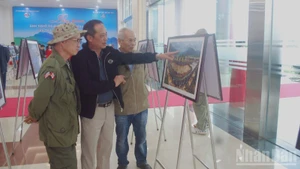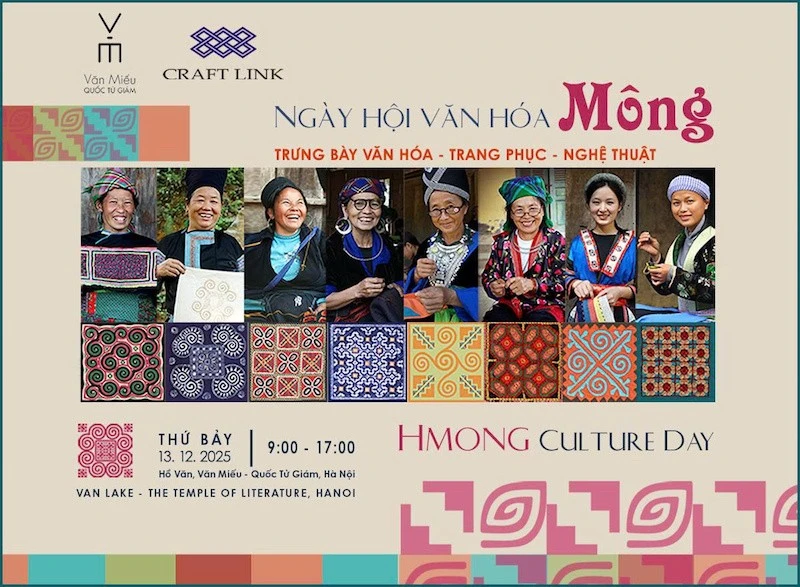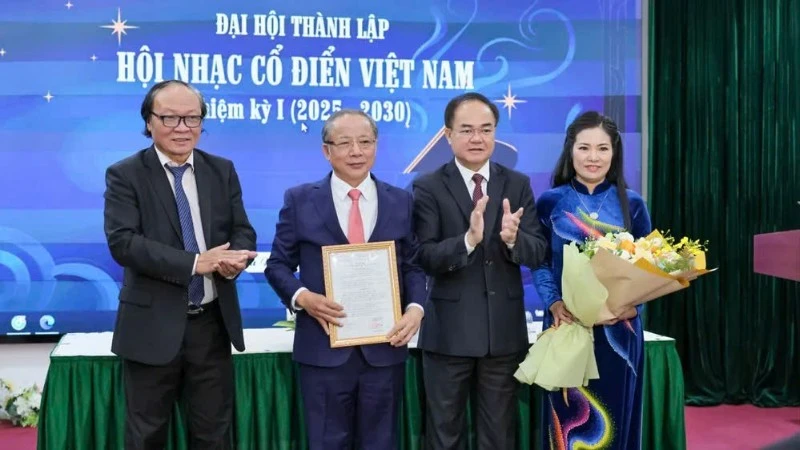Special issues of Nhan Dan Newspaper
In early November, Dung received a reporter from the Vietnam National Assembly Television Channel for a visit to his newspaper archive on Truong Chinh Street, Nam Dinh City, Nam Dinh Province. The visit was prompted by the news that Lao Vice President Sommad Pholsena was searching for the Nhan Dan issue from April 3, 1963. Dung asked the reporter to deliver this issue to Sommad Pholsena. The issue contained a front-page article featuring Prime Minister Pham Van Dong’s condolences regarding the tragic event when Sommad Pholsena's father, Kinim Pholsena, the Foreign Minister of the Kingdom of Laos, was killed by hostile forces on April 2, 1963. This loss was not only a great personal sorrow for the Pholsena family but also had a profound impact on the people of both Laos and Vietnam, as Kinim had contributed significantly to strengthening the Vietnam-Laos friendship.
On May 7, 1962, Kinim Pholsena had visited Vietnam and was received by President Ho Chi Minh. This historic visit, along with the deep ties between the two countries, was also documented and published in Nhan Dan Newspaper on May 8, 1962.
When Sommad Pholsena was handed the Nhan Dan issue with this historic message, he was very moved. The old pages of the newspaper seemed to bring back memories of his father, a man who had dedicated himself to peace and the friendship between the two nations.
According to Dung, the presentation of the historical Nhan Dan newspaper is a gesture of gratitude from a Vietnamese citizen to the special affection that Kinim and Sommad Pholsena have shown towards Vietnamese people. Though a small gift, it carries profound emotions and symbolises the enduring friendship between the two nations of Vietnam and Laos, while marking a meaningful story in the history of both peoples.
Dung recalled the story of finding a worker from the Nam Dinh Textile Complex who appeared in a photograph published in Nhan Dan on November 11, 1970. This story began on July 29, 2022, when Dung posted information on social media and asked the Nam Dinh community to help locate four female workers from the Nam Dinh Textile Complex whose photos had been featured on the front page of Nhan Dan, or their descendants and relatives. In 1970, the workers of Vu Thi Luu, Tran Thi Nga, Vu Thi Bich Lien and Tran Thi Thanh had exceeded their target by producing nearly 24,000 metres of fabric in the first nine months of the year. This achievement earned them the title of "the fastest shuttles", and their image was published on the front page of Nhan Dan Newspaper.
It was truly surprising that just one day after Dung posted his request, he received information about Vu Thi Bich Lien and immediately visited her home on Phan Boi Chau Street in Nam Dinh City to present the special edition of Nhan Dan Newspaper. Dung, born in 1961, recounted that before handing over the newspaper, he asked Lien if she knew that her photo had been published in Nhan Dan at that time. She replied that during the war period, it was extremely difficult to even hold a real newspaper, so she had no knowledge of the publication.
 |
| Dung presents the issue of Nhan Dan Newspaper to Vu Thi Bich Lien in Nam Dinh City. |
When Dung held up the newspaper and pointed to the photo, asking Lien if she recognised anyone in the picture, it was a pleasant surprise when the woman immediately pointed to the second person from the right and said "It's me" with a bright smile. According to Dung, through their conversation, he learned that the photo was taken when Lien was just 29 years old, before the Northern Vietnam Skilled Worker Contest in 1971. What’s more, he also discovered that Lien had the honour of meeting President Ho Chi Minh three times. The only regret was that Lien did not have any information about the other three workers and where they might be now.
It is hard to know how many issues of Nhan Dan Newspaper Dung has gifted, especially those with publication dates matching the birthdays of the recipients, or simply those with a photo featured in the newspaper. Of course, most of the newspapers given away were surplus issues obtained after many searches to complete the collection, but some were given freely without hesitation because they held value for preservation.
Dung also hopes to collect and preserve other cultural heritage items. As a native of Nam Dinh, he believes that talking about Nam Dinh means thinking of the Tran Dynasty, and vice versa. Therefore, he plans to name his museum "The Museum of Journalism and Dong A Cultural Heritage ". He hopes that if the museum is established, it will contribute a small part to the country’s other museums, archives, and collections by various organisations and individuals. Journalism, documents, and cultural heritage artifacts are the richest channels through which people can revisit the past and learn how the Vietnamese people have lived, worked, fought, and built and protected the country.
The dream of a museum dedicated to journalism and Dong A Cultural Heritage
The journey of collecting newspapers began with Dung’s father, Nguyen Phi Hung, who shared his story in an interview with Nhan Dan Newspaper’s Thoi Nay (Present Times) publication in June 2024. Over the past eight years, Dung has built an impressive collection of more than 400,000 newspapers and magazines, with over 100 publications that were issued in Vietnam before 1954. Among his collection are many significant items, such as Le Courrier, which was first published in 1886, as well as the first editions of newspapers including: the No.1 issue-Liberation Flag (the Central Propaganda and Agitation Agency of the Indochinese Communist Party); the Spring edition of the Cuu Quoc (Nation Salvation) Newspaper, published on January 5, 1943; Gia Dinh Newspaper, which first published in 1865 in Saigon; and Phu nu tan van (Modern Women) Newspaper, which first issued in 1929 in Saigon. However, the majority of his collection consists of more modern and well-known newspapers such as Nhan Dan, Quan doi Nhan dan (People’s Army), Tien Phong (Pioneers), Thanh Nien (Youth), and others. These newspapers not only represent important milestones in Vietnamese history but also reflect the development of the press and its role in documenting the nation's evolution.
Dung shared that his journey into collecting newspapers and magazines was partly driven by his father's passion, which he wanted to keep alive, and partly by his desire to ensure that the valuable artifacts collected by both father and son would be well-preserved and useful to the community as well as future generations. This is the reason why he aims to establish Vietnam's first private newspaper museum. He considers 2024 to be the right time for this endeavour, as he has accumulated over 20 tonnes of newspapers and magazines, ranging from one year to several decades old, while some are even more than 100 years old. This achievement earned him the recognition from the Vietnam Record Organisation, which awarded him the certificate for having the largest collection of newspapers issued in Vietnam from the late 19th century to the present.
Another reason that drives Dung to pursue the idea of a private newspaper museum is the upcoming 100th anniversary of Vietnam’s Revolutionary Press Day on June 21, 2025. The establishment of the museum is not only meant to celebrate this milestone but also to use it as a starting point for a new chapter: continuing to collect more materials to serve the community and preserve even more artifacts for future generations.
















